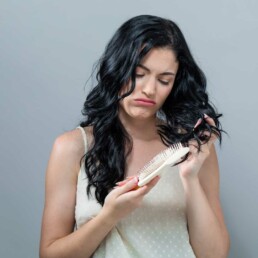Damaged hair can be a real headache, causing everything from split ends to hair breakage and thinning. But what exactly does damaged hair look like? Well, it can take many forms, from frizz and tangles to dullness and breakage. Understanding the signs of damaged hair can help you take the right steps to repair and restore your locks. In this article, we’ll explore the common signs of damaged hair, so you can give your hair the care it deserves.
What Does Damaged Hair Look Like?
Here are some common signs of damaged hair:
- Split ends: When the ends of the hair shafts are frayed, it creates a split or forked appearance.
- Dryness: Damaged hair often appears dry and rough, lacking the natural shine and softness of healthy hair.
- Dullness: Damaged hair can lose its luster, looking dull and lifeless.
- Breakage: Hair that is damaged is more prone to breaking, especially when brushed or styled.
- Tangles and knots: Damaged hair can become tangled and knotted easily, making it difficult to comb or brush.
- Lack of elasticity: Healthy hair can stretch and return to its original shape, but damaged hair may not have this elasticity.
- Color fading: Over-processed hair can fade quickly, losing its vibrancy and becoming brassy or dull.
Recognizing the signs of damaged hair is the first step towards restoring your hair’s health and beauty. If you notice any of these signs, it’s time to give your hair some extra TLC with nourishing and restorative hair care products.


how to know if you hair is damaged?
There are several signs that can indicate if your hair is damaged. One of the most common signs is split ends, which occur when the protective outer layer of the hair cuticle becomes damaged and splits into two or more strands. Other signs include dryness, brittleness, dullness, lack of elasticity, and excessive tangling or shedding. Additionally, if your hair is regularly exposed to heat styling tools, chemical treatments, or environmental stressors, it is more likely to be damaged. If you’re experiencing any of these signs, it’s important to take steps to repair and strengthen your hair to prevent further damage.
Damaged Hair Men
Damaged hair is a common problem for both men and women. Men can experience hair damage due to various factors, including frequent use of hair styling products, heat styling tools, chemical treatments, and environmental stressors such as sun exposure and pollution. Damaged hair in men may appear dull, dry, brittle, and prone to breakage. It may also have split ends, frizz, and a lack of volume.
Fortunately, there are many hair care products and treatments available, including Aveda’s Botanical Repair line, that can help restore and strengthen damaged hair in men. A healthy hair care routine, including regular trims, avoiding excessive heat and chemical treatments, and using protective products, can also help prevent further hair damage.
Damaged Curly Hair
Curly hair is more prone to damage due to its delicate structure and natural dryness. Common signs of damaged curly hair include split ends, frizz, breakage, and a lack of curl definition. Damaged curly hair may also feel rough and dry to the touch.
To combat these issues, it’s essential to use hair care products that are specifically formulated for curly hair. Look for products that contain natural oils and moisturizing ingredients, such as shea butter and coconut oil. Using a wide-tooth comb or your fingers to detangle wet hair gently can also help prevent breakage. Deep conditioning treatments, such as hair masks, can also help restore moisture and repair damage. Additionally, avoiding heat styling tools and limiting exposure to UV rays and pollutants can help prevent further damage to curly hair.
Heat Damaged Hair
Heat styling tools like flat irons, curling wands, and hair dryers can cause heat damage to your hair. Heat damage occurs when the heat from these tools removes moisture from your hair, leading to dryness, breakage, and split ends. Heat-damaged hair may also appear frizzy, dull, and lifeless. To prevent heat damage, it’s essential to use a heat protectant product before using any heat styling tools. It’s also important to use these tools on a low or medium heat setting and avoid excessive use. You can also consider air-drying your hair instead of using heat styling tools.


Perm Damaged Hair
Perming can be a fun way to add curls or waves to your hair, but it can also lead to damage if not done properly. The chemicals used in the perming process can break down the hair’s natural protein structure, making it weak and prone to breakage. This can result in hair that appears dry, frizzy, and lifeless. To minimize the damage caused by perming, it is essential to use high-quality, gentle hair products that nourish and strengthen the hair. A regular deep conditioning treatment can also help to restore moisture and improve the overall health of permed hair.
Damaged Relaxed Hair
Relaxing hair involves the use of chemicals to permanently straighten and smooth out hair. While the results can be beautiful, the process can also cause significant damage to the hair. Signs of damaged relaxed hair can include dryness, breakage, split ends, and loss of elasticity. Hair may also feel limp and lifeless, lacking the volume and body it once had. It’s important to take steps to care for and repair damaged relaxed hair, such as using gentle shampoos and conditioners, limiting heat styling, and incorporating regular deep conditioning treatments.
Damaged Hair Strand
A damaged hair strand refers to a hair fiber that has lost its natural structure and strength due to various factors such as heat styling, chemical treatments, and environmental stressors. Damaged hair strands may appear dry, brittle, and dull, and can also have split ends and frizz. It is essential to treat damaged hair strands to prevent further breakage and promote healthy hair growth.
Sun Damaged Hair
Exposure to the sun can cause significant damage to hair, including dryness, brittleness, split ends, and color fading. Sun damage is more pronounced in color-treated hair, as the sun’s UV rays can break down the hair’s pigment molecules, leading to discoloration and fading.
To protect your hair from sun damage, it’s essential to use hair care products with SPF or wear a hat when spending time outdoors. You can also use leave-in conditioners or hair oils with UV protection to shield your hair from the sun’s rays. After sun exposure, deep conditioning treatments can help repair any damage and restore moisture to your hair. It’s also essential to avoid excessive heat styling and chemical treatments, as these can further weaken sun-damaged hair.
Chemically Damaged Hair
Chemically damaged hair occurs when you use harsh chemicals such as relaxers, hair dyes, and perms, which can cause hair breakage, dryness, and scalp irritation. Chemically damaged hair may appear dry, brittle, and lifeless, with split ends and a lack of volume. To prevent chemical damage, it’s important to use these products as directed, avoid overlapping applications, and take breaks between chemical treatments. It’s also essential to use a deep conditioning treatment regularly to nourish and strengthen your hair.
Damaged Hair Follicles
Damaged hair follicles can occur due to several reasons, including hormonal changes, genetics, excessive heat styling, and harsh chemical treatments. This can lead to hair thinning, balding, and hair breakage. It’s important to maintain a healthy scalp and hair care routine to prevent further damage and promote hair growth. Regular scalp massages, gentle hair care products, and a balanced diet can help improve the health of hair follicles. In severe cases, consulting a dermatologist or a hair care specialist may be necessary.

Frequently Asked Questions about Damaged Hair
Are you tired of dealing with damaged hair? Do you have questions about how to prevent, treat, and restore your hair’s health? In this section, we will answer some of the most frequently asked questions about damaged hair, including what causes it, how to identify it, and what treatments and products can help. Let’s dive in and learn how to get your hair looking and feeling healthy again!
Toner itself doesn’t typically damage hair, but the process of toning hair can potentially cause damage. The use of toner usually involves bleaching the hair first, which can be damaging to the hair. Additionally, if the toner is left on the hair for too long, it can cause over-processing and damage to the hair. It’s important to have a professional hair stylist apply toner to minimize any potential damage and to use a hair care routine that focuses on repairing and protecting the hair.
Purple shampoo is specifically formulated for blonde, gray, and white hair to counteract brassiness and maintain cool tones. When used correctly, purple shampoo should not damage hair. However, overuse or leaving the shampoo on for too long can lead to dryness and damage. It is recommended to use purple shampoo once or twice a week and follow with a moisturizing conditioner to prevent dryness and maintain hair health.
Highlights can cause damage to hair if they are not done properly or if the hair is already weakened or damaged. Bleaching or lightening agents used to create highlights can strip the hair of its natural oils and proteins, leading to dryness, breakage, and split ends. However, if the highlights are done by a professional stylist and the hair is properly maintained with conditioning treatments, the damage can be minimized.
Semi-permanent hair dye is generally considered less damaging than permanent hair dye because it doesn’t contain harsh chemicals like ammonia or peroxide that can damage the hair. However, semi-permanent dyes can still cause some damage to the hair if used excessively or if the hair is already damaged. It’s always best to consult with a professional stylist to determine the best hair dye option for your specific hair type and needs.
At Charm and Champagne Beauty Studio, we understand that many of our clients have concerns about the potential damage that hair treatments and products can cause. One common concern is whether using a developer during hair coloring can lead to damaged hair. Therefore, it’s important to pay attention to the level of developer being used during the coloring process. At Charm and Champagne Beauty Studio, we always use the appropriate developer for each individual’s hair type and color goals, to minimize any potential damage. Additionally, we recommend using a deep conditioning treatment, such as Aveda’s Botanical Repair line, to restore and strengthen hair after any chemical treatment. With proper care and maintenance, you can enjoy beautifully colored hair without sacrificing its health and vitality.
Bleaching your hair can damage it, and in some cases, the damage can be permanent. When you bleach your hair, you strip away the natural pigment and moisture from your strands, which can leave them dry, brittle, and prone to breakage. In severe cases, bleaching can cause the hair to become so damaged that it begins to break off, leaving you with patchy, uneven hair. However, not all bleaching treatments are created equal, and the amount of damage that your hair sustains will depend on several factors, such as the strength of the bleach, the length of time it’s left on the hair, and the condition of your hair prior to the treatment. To minimize the risk of permanent damage, it’s important to use high-quality bleach and to follow a proper hair care routine, including the use of Aveda’s Botanical Repair line to strengthen and repair damaged hair.
Sea salt spray can be drying to the hair, especially if used excessively or on already damaged hair. It can cause the hair to become brittle and break, leading to further damage. However, if used in moderation and on healthy hair, it can create beautiful texture and volume without causing damage. It’s important to use a hydrating and nourishing hair care routine to maintain healthy hair, especially if you use sea salt spray frequently.
Hairspray, when used in moderation, does not typically damage hair. However, using too much hairspray or using it too often can cause dryness and breakage. It is important to use hairspray as directed and to wash it out of your hair thoroughly to avoid buildup.
Yes, excessive heat styling, including straightening, can damage hair by breaking down the hair’s protein structure and causing dryness, split ends, and breakage. It’s important to use heat protectant products and avoid using heat tools on high heat settings.
Sun-In is a hair lightening spray that contains hydrogen peroxide, which can damage hair if used excessively or improperly. It can cause dryness, breakage, and brittleness, especially if hair is already damaged or fragile. It’s important to follow the instructions carefully and avoid overuse.
To fix heat damaged hair, the first step is to give your hair a break from heat styling tools. This means avoiding blow dryers, flat irons, and curling irons for a while. Additionally, it’s essential to keep your hair hydrated and nourished with regular deep conditioning treatments and using a leave-in conditioner. Trim off the damaged ends regularly to prevent further breakage, and try to air dry your hair as often as possible. Lastly, using a heat protectant product before heat styling can help prevent future heat damage.
To fix damaged bleached hair, it’s important to nourish the hair with protein-rich treatments, use a gentle shampoo and conditioner formulated for damaged hair, avoid heat styling tools, and minimize exposure to sunlight.
Curly hair can be prone to damage and breakage. To fix damaged curly hair, use a sulfate-free shampoo and conditioner, deep condition regularly, use a diffuser when blow-drying, and avoid using heat styling tools that can damage the hair.
To fix dry damaged hair, use a deep conditioning treatment or hair mask, avoid using hot water to wash your hair, use a leave-in conditioner, avoid heat styling tools, and minimize exposure to sunlight and harsh chemicals.
Chemically damaged hair can be repaired through a combination of deep conditioning, protein treatments, and limiting further chemical processing. Using products specifically formulated for chemically treated hair, such as Aveda’s Damage Remedy line, can help restore moisture and strengthen the hair. Avoiding heat styling tools and opting for protective hairstyles can also aid in the repair process. Consulting with a professional stylist or trichologist can also provide additional guidance on the best course of action for repairing chemically damaged hair.

